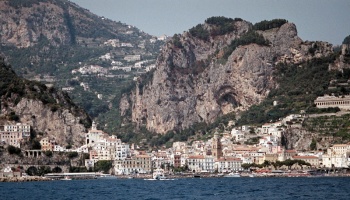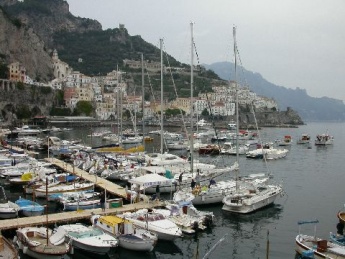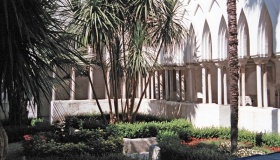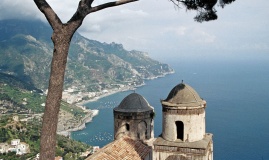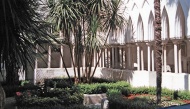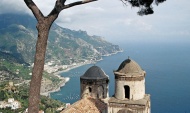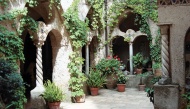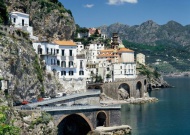Amalfi
From CruisersWiki
m (bot: Move Communication) |
Istioploos (Talk | contribs) (Template) |
||
| Line 2: | Line 2: | ||
{{TOC block}} | {{TOC block}} | ||
| - | {{Infobox |40 | + | {{Infobox |
| - | | zoom= | + | | lat= 40.63233| lon=14.60217 |
| + | | name= Amalfi | ||
| + | | portofentry= | ||
| + | | zoom= 15 | ||
| + | | chartlet = y | ||
| image= AmalfiTown.jpg | | image= AmalfiTown.jpg | ||
| imagetext= Amalfi from seaward | | imagetext= Amalfi from seaward | ||
| - | + | | summary= The town and harbour of '''Amalfi''' lie 16 miles E of Capo Punta Campanella, the headland at the SE extremity of the Bay of [[Naples]], and eight miles W of [[Salerno]] on the Tyrrhenian coast of [[Italy]]. The town lies at the end of a steep ravine on a coast famed for its dramatic scenery and picturesque mountain villages. An independent republic for 500 years from the 7th century AD, Amalfi was one of the peninsula’s most successful maritime trading entities, a position only eclipsed in the 12th century by the growing power of Pisa and [[Genoa]]. However, Amalfi’s maritime code, the ''Tavole Amalfitane'', formed the basis of maritime law around the Mediterranean for at least another 400 years. An earthquake and tsunami in 1343 destroyed much of the town and obliterated the harbour, an event from which the town never fully recovered. However, a modest tourist boom beginning in the 1920s, when Amalfi was discovered by the British monied classes, has brought new prosperity to the town. Unfortunately, it has also filled its harbour to bursting point and space along its single mole is at a premium during the summer months. Shelter is reasonable here but the harbour becomes very uncomfortable in strong winds from S or SE, when [[Salerno]] is a better bet. | |
| - | + | | notes= | |
| - | The town and harbour of Amalfi lie 16 miles E of Capo Punta Campanella, the headland at the SE extremity of the Bay of [[Naples]], and eight miles W of [[Salerno]] on the Tyrrhenian coast of [[Italy]]. | + | | news= |
| + | }} | ||
==Charts== | ==Charts== | ||
| Line 20: | Line 25: | ||
==Weather== | ==Weather== | ||
| - | Winds along the Tyrrhenian Coast of Italy are generally light in the summer months. The most notable feature is a SW | + | Winds along the Tyrrhenian Coast of Italy are generally light in the summer months. The most notable feature is a SW sea breeze that kicks in in late morning and blows at little more than Force 2 - 4 until the evening. Thundery conditions are not infrequent during early Spring and Autumn, and associated winds can sometimes reach gale force and kick up a substantial sea. In winter, gales can blow from both NW and S and entry to and exit from some of the harbours along the coast can become hazardous. |
Sources for weather information: | Sources for weather information: | ||
| - | * There is a continuous ( | + | * There is a continuous (computerized voice) weather forecast on VHF 68 - first in Italian and then followed with an English translation |
* The same forecast is given in Italian and English on VHF coastal stations following a notification on channel 16 | * The same forecast is given in Italian and English on VHF coastal stations following a notification on channel 16 | ||
* Navtex weather forecasts are broadcast from stations at La Garde (Toulon), Roma and Cagliari ([[Sardinia]]) | * Navtex weather forecasts are broadcast from stations at La Garde (Toulon), Roma and Cagliari ([[Sardinia]]) | ||
==Passages== | ==Passages== | ||
| - | + | ''See [[Mediterranean#Mediterranean_Passages|Mediterranean]]''. | |
| - | + | ||
==Islands== | ==Islands== | ||
| Line 35: | Line 39: | ||
==Communication== | ==Communication== | ||
| + | {{Green|Add here VHF channel for the coastguard, harbor masters. etc.}} | ||
* | * | ||
* | * | ||
| Line 41: | Line 46: | ||
==Navigation== | ==Navigation== | ||
| - | The ravine at the foot of which the town sits is difficult to identify along the mountainous coastline. | + | The ravine at the foot of which the town sits is difficult to identify along the mountainous coastline. The cupola of the cathedral is conspicuous in the centre of the town and closer in the harbour mole and the masts of yachts lying along it and on the numerous small craft pontoons will be seen. The end of the mole should be given a generous clearance to avoid the rock ballasting and there are numerous small craft mooring to be avoided in the harbour. |
| + | |||
| + | {{Note}}Access to the harbour is only permitted from 0800 to 2000. | ||
==Berthing== | ==Berthing== | ||
| - | {{ | + | {{poi | lat= 40.63173| lon=14.60151 |
| + | | type= harbour | ||
| + | | name= Porto di Amalfi | ||
| + | | altname= | ||
| + | | url = http://www.portoamalfi.com | ||
| + | | zoom= 17 | ||
| + | | portofentry= | ||
| + | | image= AmalfiMoorings.jpg | ||
| + | | imagetext= ''Marina Coppola'' pontoon moorings | ||
| + | | text= There are a total of 300 berths in the harbour, of which three are supposedly for yachts in transit. Maximum length 40 metres. These berths are towards the outer end of the quay along the harbour breakwater, close to the fuel berth. The depths here are 4.0 - 6.0 metres. You will need to use your anchor to moor bows or stern-to the quay. | ||
| - | + | Alternatively, there may be space on the so-called ‘Marina Coppola’ pontoons operated by the Coppola family. The pontoons, which lie to the N of the small craft moorings, accept vessels of up to 35 meters on laid moorings. The ‘marina’ offers a range of services, including water and electricity, laundry service and mooring assistance. | |
| + | : {{email|[email protected]}}; Tel: {{phone|39|089|873 091}}; Fax: {{fax|39|089|857 538}}; Mobile: {{mob|39|339|224 484}}; VHF channel XX | ||
| + | }} | ||
===Marinas & Yacht Clubs=== | ===Marinas & Yacht Clubs=== | ||
None. | None. | ||
| - | + | ==Anchorages== | |
| - | It is possible in settled weather only to anchor off to the E of the harbour, clear of the small craft moorings, in depths of 8.0 - 10.0 metres. | + | It is possible in settled weather only to anchor off to the E of the harbour, clear of the small craft moorings, in depths of 8.0 - 10.0 metres. The holding is good in mud. |
| - | == | + | ==Amenities== |
| - | + | {{tlist | |
| - | {{ | + | |
| - | + | ||
| - | + | |header|Facilities | |
| - | + | ||
| - | + | |Water| Some water points on the quay and on the ‘marina’ pontoons | |
| - | + | |Electricity|Eelectricity on the ‘marina’ pontoons | |
| + | |Toilets| {{MagentaText|?}} | ||
| + | |Showers| {{MagentaText|?}} | ||
| + | |Laundry| Laundry service at '''Marina Coppola''' | ||
| + | |Garbage| Bins around the harbour | ||
| - | + | |header|Supplies | |
| - | + | |Fuel| Fuel station at the outer end of the quay (0800 - 2000, summer only) | |
| - | + | |Bottled gas| {{MagentaText|?}} | |
| + | |Chandlers| {{MagentaText|?}} | ||
| - | + | |header|Services | |
| - | + | |Repairs| Very limited | |
| - | + | |Internet| Free WiFi | |
| - | + | |Mobile connectivity| {{MagentaText|?}} | |
| - | + | |Vehicle rentals| Rental outlets in the town | |
| - | + | }} | |
| - | == | + | ==Provisioning== |
| - | * Good provisions shops in the town | + | * Good provisions shops in the town |
| - | * The town, like Sorrento, is famous for its ''limoncello'' | + | * The town, like Sorrento, is famous for its ''limoncello'' liqueur |
| - | == | + | ==Eating out== |
Numerous restaurants, pizzerias and bars up in the town. | Numerous restaurants, pizzerias and bars up in the town. | ||
| - | ==== | + | ==Transportation== |
| - | + | * Buses to [[Sorrento]], [[Salerno]] and [[Naples]] | |
| + | * Daily buses to Ravello (15). | ||
| + | * Summer ferries to [[Naples]], [[Salerno]], [[Capri]] and [[Ischia]]. | ||
| - | == | + | ==Tourism== |
| - | + | The town of Amalfi, built at the foot of a mountainous ravine, is very colourful and it is well worth exploring its narrow whitewashed alleys climbing the hillside and the Moorish-style arcades along its streets. Its cathedral, the Duomo Sant’Andrea, has 11th century bronze doors cast in Constantinople, a polychrome marble altar, atmospheric 13th century cloisters (admission charge) and a crypt with the tomb of St Andrew (Sant’Andrea). | |
| - | + | From the town, one can catch a bus up to the World Heritage-listed village of Ravello, perched on a huge crag above Amalfi. Here lies the idyllically-sited Villa Cimbrone, much frequented by the English Bloomsbury set and boasting lovely gardens where one can lunch on the terrace looking out over the sea. Nearby is the equally splendid Villa Rufolo, like Villa Cimbrone built on the remains of an earlier monastery, its gardens smaller and less impressive but again with a spectacular view. Its last permanent resident was the German composer Wagner, in whose memory Ravello hosts an annual classical music festival each July. | |
| - | + | ||
| - | + | Finally, Amalfi is the start of the famous Amalfi Drive, a Roman road carved for 50 miles along the coast from Amalfi to Sorrento, with spectacular views of the sea and picturesque villages clinging to the cliffs. | |
| - | + | ||
| - | ==== | + | {{hgallery| |
| - | + | {{himage|AmalfiCloisters.jpg|Cloisters of Amalfi cathedral}} | |
| - | + | {{himage|AmalfiRavello.jpg|Amalfi coast from Ravello}} | |
| - | + | {{himage|AmalfiRufolo.jpg|Villa Rufolo, Ravello}} | |
| + | {{himage|AmalfiDrive.jpg|Typical scenery on the Amalfi Drive}} | ||
| + | }} | ||
| + | |||
| + | <center style="clear: both;"><gallery widths="190px" heights="140px" perrow="2"> | ||
| + | Image:AmalfiCloisters.jpg|Cloisters of Amalfi cathedral | ||
| + | Image:AmalfiRavello.jpg|Amalfi coast from Ravello | ||
| + | Image:AmalfiRufolo.jpg|Villa Rufolo, Ravello | ||
| + | Image:AmalfiDrive.jpg|Typical scenery on the Amalfi Drive | ||
| + | </gallery></center> | ||
==Friends== | ==Friends== | ||
| Line 110: | Line 139: | ||
==Links== | ==Links== | ||
* {{wikipedia}} | * {{wikipedia}} | ||
| + | * {{Wikivoyage}} | ||
* | * | ||
| Line 115: | Line 145: | ||
''See [[Italy#References & Publications|Italy]]''. | ''See [[Italy#References & Publications|Italy]]''. | ||
| - | {{Comments | + | {{Comments}} |
* | * | ||
* | * | ||
| Line 129: | Line 159: | ||
{{Contributors|[[User:Lighthouse|Lighthouse]], [[User:Atheneoflymington|Athene of Lymington]]}} | {{Contributors|[[User:Lighthouse|Lighthouse]], [[User:Atheneoflymington|Athene of Lymington]]}} | ||
| - | [[Category:Ports - Italy]] | + | [[Category:Ports - Italy]] [[Category:Anchorages - Italy]] |
Revision as of 18:00, 26 May 2018
| Amalfi
| |
| | |
The town and harbour of Amalfi lie 16 miles E of Capo Punta Campanella, the headland at the SE extremity of the Bay of Naples, and eight miles W of Salerno on the Tyrrhenian coast of Italy. The town lies at the end of a steep ravine on a coast famed for its dramatic scenery and picturesque mountain villages. An independent republic for 500 years from the 7th century AD, Amalfi was one of the peninsula’s most successful maritime trading entities, a position only eclipsed in the 12th century by the growing power of Pisa and Genoa. However, Amalfi’s maritime code, the Tavole Amalfitane, formed the basis of maritime law around the Mediterranean for at least another 400 years. An earthquake and tsunami in 1343 destroyed much of the town and obliterated the harbour, an event from which the town never fully recovered. However, a modest tourist boom beginning in the 1920s, when Amalfi was discovered by the British monied classes, has brought new prosperity to the town. Unfortunately, it has also filled its harbour to bursting point and space along its single mole is at a premium during the summer months. Shelter is reasonable here but the harbour becomes very uncomfortable in strong winds from S or SE, when Salerno is a better bet.
Charts
- British Admiralty
- 1908
- 908
- Italian
- 914
- 10
- 132
Weather
Winds along the Tyrrhenian Coast of Italy are generally light in the summer months. The most notable feature is a SW sea breeze that kicks in in late morning and blows at little more than Force 2 - 4 until the evening. Thundery conditions are not infrequent during early Spring and Autumn, and associated winds can sometimes reach gale force and kick up a substantial sea. In winter, gales can blow from both NW and S and entry to and exit from some of the harbours along the coast can become hazardous.
Sources for weather information:
- There is a continuous (computerized voice) weather forecast on VHF 68 - first in Italian and then followed with an English translation
- The same forecast is given in Italian and English on VHF coastal stations following a notification on channel 16
- Navtex weather forecasts are broadcast from stations at La Garde (Toulon), Roma and Cagliari (Sardinia)
Passages
See Mediterranean.
Islands
Communication
Add here VHF channel for the coastguard, harbor masters. etc.
Also see World Cruiser's Nets.
The ravine at the foot of which the town sits is difficult to identify along the mountainous coastline. The cupola of the cathedral is conspicuous in the centre of the town and closer in the harbour mole and the masts of yachts lying along it and on the numerous small craft pontoons will be seen. The end of the mole should be given a generous clearance to avoid the rock ballasting and there are numerous small craft mooring to be avoided in the harbour.
Note: Access to the harbour is only permitted from 0800 to 2000.
Berthing
Porto di Amalfi
There are a total of 300 berths in the harbour, of which three are supposedly for yachts in transit. Maximum length 40 metres. These berths are towards the outer end of the quay along the harbour breakwater, close to the fuel berth. The depths here are 4.0 - 6.0 metres. You will need to use your anchor to moor bows or stern-to the quay.
Alternatively, there may be space on the so-called ‘Marina Coppola’ pontoons operated by the Coppola family. The pontoons, which lie to the N of the small craft moorings, accept vessels of up to 35 meters on laid moorings. The ‘marina’ offers a range of services, including water and electricity, laundry service and mooring assistance.
- [email protected]; Tel: +39 (089) 873 091; Fax: +39 (089) 857 538; Mobile: +39 (339) 224 484; VHF channel XX
Marinas & Yacht Clubs
None.
Anchorages
It is possible in settled weather only to anchor off to the E of the harbour, clear of the small craft moorings, in depths of 8.0 - 10.0 metres. The holding is good in mud.
Amenities
| Facilities | |
|---|---|
| Water | Some water points on the quay and on the ‘marina’ pontoons |
| Electricity | Eelectricity on the ‘marina’ pontoons |
| Toilets | ? |
| Showers | ? |
| Laundry | Laundry service at Marina Coppola |
| Garbage | Bins around the harbour |
| Supplies | |
| Fuel | Fuel station at the outer end of the quay (0800 - 2000, summer only) |
| Bottled gas | ? |
| Chandlers | ? |
| Services | |
| Repairs | Very limited |
| Internet | Free WiFi |
| Mobile connectivity | ? |
| Vehicle rentals | Rental outlets in the town |
Provisioning
- Good provisions shops in the town
- The town, like Sorrento, is famous for its limoncello liqueur
Eating out
Numerous restaurants, pizzerias and bars up in the town.
Transportation
- Buses to Sorrento, Salerno and Naples
- Daily buses to Ravello (15).
- Summer ferries to Naples, Salerno, Capri and Ischia.
Tourism
The town of Amalfi, built at the foot of a mountainous ravine, is very colourful and it is well worth exploring its narrow whitewashed alleys climbing the hillside and the Moorish-style arcades along its streets. Its cathedral, the Duomo Sant’Andrea, has 11th century bronze doors cast in Constantinople, a polychrome marble altar, atmospheric 13th century cloisters (admission charge) and a crypt with the tomb of St Andrew (Sant’Andrea).
From the town, one can catch a bus up to the World Heritage-listed village of Ravello, perched on a huge crag above Amalfi. Here lies the idyllically-sited Villa Cimbrone, much frequented by the English Bloomsbury set and boasting lovely gardens where one can lunch on the terrace looking out over the sea. Nearby is the equally splendid Villa Rufolo, like Villa Cimbrone built on the remains of an earlier monastery, its gardens smaller and less impressive but again with a spectacular view. Its last permanent resident was the German composer Wagner, in whose memory Ravello hosts an annual classical music festival each July.
Finally, Amalfi is the start of the famous Amalfi Drive, a Roman road carved for 50 miles along the coast from Amalfi to Sorrento, with spectacular views of the sea and picturesque villages clinging to the cliffs.
Friends
Contact details of "Cruiser's Friends" that can be contacted for local information or assistance.
Forums
List links to discussion threads on partnering forums. (see link for requirements)
Links
References & Publications
See Italy.
Comments
We welcome users' contributions to the Wiki. Please click on Comments to view other users' comments, add your own personal experiences or recommend any changes to this page following your visit.
Verified by
Date of member's last visit to Amalfi and this page's details validated:
- July/August 2003--Athene of Lymington 12:18, 16 December 2010 (UTC)
| This is a usable page of the cruising guide. However, please contribute if you can to help it grow further. Click on Comments to add your personal notes on this page or to discuss its contents. Alternatively, if you feel confident to edit the page, click on the edit tab at the top and enter your changes directly. |
| |
|---|
|
Names: Lighthouse, Athene of Lymington |
